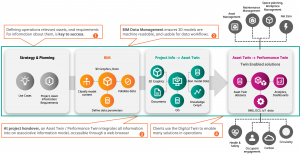Anand Mecheri, CEO of Invicara, aims to alleviate the confusion around the concept of digital twins and highlight the importance of good data in construction
Confusion often surrounds the term “digital twin”, which can mean many things to different people, depending on their background and experience. Digital twins have a multitude of applications, for example, healthcare, manufacturing, supply chain and where we will focus this article: the built environment.
To start, let’s use the word “asset” to illustrate the confusion surrounding digital twins. An asset is defined as being something of value, which can be either financial or physical, and can describe many different things depending on the context. A financial asset can mean a brand, cash, inventory, stocks, bonds, etc. A physical asset can mean a vehicle, a building, equipment like a pump, furniture and so on.
When you read the word “asset”, what came to mind? The answer is probably different for each person who reads this. Imagine a conversation involving an “asset” without properly qualifying what it is with this person, who could be from a very different domain to you. I suspect the conversation wouldn’t last too long!
What is key to differentiating between these different types of assets?
Context and good data. Once we add context to data, we can derive information, which allows the users to understand the use of asset in a given setting. This is no different when we talk about a digital twin.
While the term “digital twin” has been around for some time now, its meaning remains enigmatic to some, as it can be applied to a variety of things across many industries.
Different types of assets in the built environment, an energy grid system, manufactured products and a manufacturing process, are just some examples. And within each of those industry segments, digital twins can mean any number of specific solutions that target specific use cases.
How can we in the construction industry alleviate confusion surrounding digital twins?
1. We must recognise that digital twin is a ubiquitous term to describe an array of solutions that may sit within any stage of a project’s lifecycle (planning, design, construction, commissioning, operations).
2. Remove bias by not having a constrained view of what a digital twin is, based on one’s area of expertise/exposure. As mentioned before, “digital twin” can mean different things to others and we must allow for that.
3. Recognise that digital twins can either be pre-baked “products” (picture a square peg that will fit into a hole of the same size) or customised solutions that are composed to address vast array of use cases.
4. Distinguish between the adjacent but distinct concepts of “twinning” (creating the world model) and “twin-enabled solutions” (use case-driven solutions that leverage and extend the world model).
5. Recognise that the expertise for twinning and expertise to build twin-enabled solutions may come from very different firms, across various phases of the asset’s lifecycle.

The importance of good data in construction
Understanding the role that data quality plays to create a digital twin is key to breaking down further confusion surrounding digital twins. But what is considered “good” data quality?
The 21st century has seen an unprecedented explosion in the generation of data, making it ubiquitous within almost every aspect of our lives. This is especially pertinent when focusing on the construction industry, where projects are usually large scale, group orientated and complicated, surrounded by ageing traditional practices that aren’t conducive to delivering projects today.
To attain good data quality, we must follow these principles:
1. Understand what data is useful and needed to deliver valuable outcomes. With the amount of data involved in a construction project, it’s key to pick out the data that the end user requires. Failing to do this wastes resources transforming it into “good data”.
2. Identify an independent stakeholder, responsible for gathering data and assemble it into a coordinated repository for subsequent retrieval and consumption.
3. Attaining large datasets has its merits but without validation, it becomes untrustworthy. Each dataset should be reviewed against its requirements and its validity assessed and communicated, giving the end user confidence and clarity.
4. A maintenance procedure should be established to ensure validated data is in date. What use is it if not?
5. The ability to contextualise the data that has been prescribed, gathered, validated and maintained is paramount. Data without context offers little value. After all, adding context to data results in information, and information is where the value lies.
6. Finally, data needs to be presented in way that is meaningful and useful to the end user.
The future of digital twins and their application
In order for us to have meaningful conversations about the future of digital twins and their application, we must be open to all interpretations of the term and not rely on our own viewpoint as a single source. Good data quality can ensure we develop robust digital twins that are unbiased and a definitive source of truth among a barrage of data in construction. This will open all sorts of opportunities for strategic decision-making to meet more often with reality.
Anand Mecheri
CEO
Invicara
Tel: (+44) 020 3965 2270

















